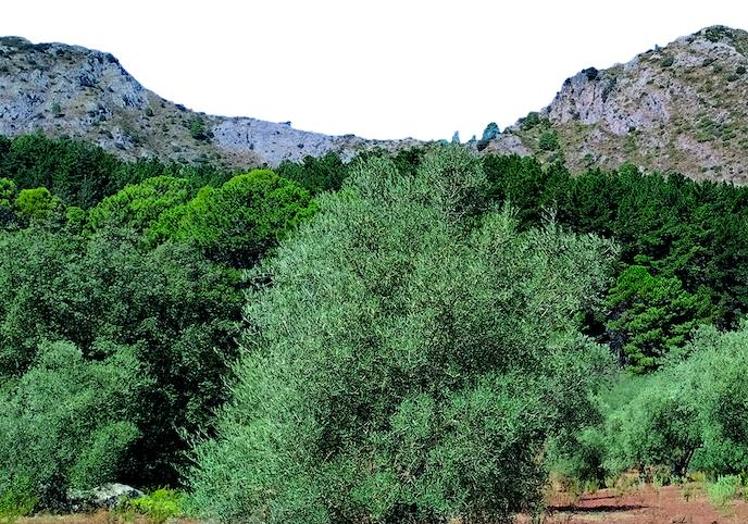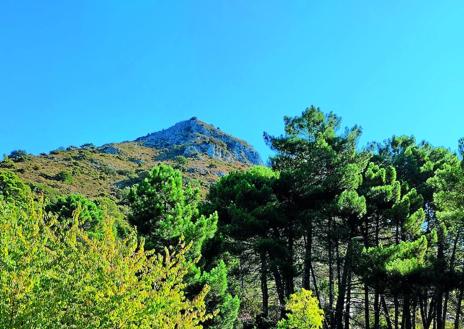A trip to the fairy-tale forest of Juanar
Just 25 minutes by car separates the lively coast metropolis of Marbella with one of the most extraordinary landscapes of the Costa del Sol and Andalucía
Gabriela Berner
Marbella
Wednesday, 19 July 2023, 10:13
This rich natural area is part of the Sierra Blanca, over 6,500 hectares of white limestone and marble mountains that serve as a backdrop to Marbella. What’s more, it is the gate to the Sierra de las Nieves, the most recently declared national park in Andalucía. El Juanar lies between relatively high ridges and peaks such as La Concha (1,215), Cerro del Lastonar (1,275) and Cruz de Juanar (1,184).
Whether you are coming from Marbella or Coín, the turning for El Juanar off the A-355 is clearly signposted. From there, it is a further five kilometres along a narrow, winding, high mountain road through a rich pine forest, which has an altitude of 800 metres.
To the left there are steep crags, to the right a deep gorge, which is a lot safer today than in previous years. Behind the valley you can see more impressively high rock formations.
The road, which turns into a sand track, continues to ascend until it reaches a large metal gate, which vehicles cannot go through. However, on the day of our visit we had already left our car at the Refugio de Juanar forest hotel, which was clearly signposted 300 metres down the road. This way we could enjoy the walk for longer, a decision that was definitely worth it.
After the gate the path goes steadily uphill in sweeping curves. Soon the pine forest becomes thinner and views of the smaller rock formations can be seen, which are among vegetation rich with a variety of species such as rosemary, thyme and lavender.
The scent mixes with the aromas of heather, hawthorn, broom, juniper and more, which is soothing for the lungs.
To the right, deciduous trees are in abundance, and as we climb we catch glimpses of the plateau beyond between their trunks. This area, which has been reforested with conifers and deciduous trees, is still used for agriculture in some parts.



Ibex paradise
Ignoring the various signposts offering different walks in other directions, we stayed on the same path, which led us to our first stop, the Mirador del Macho Montés. This is a point with an incredible view of Marbella and all the way across the Mediterranean to the Moroccan coast. There is a strikingly realistic bronze sculpture of an Iberian mountain goat, or ibex, mounted on a rock next to the viewpoint.
It is actually quite common to spot this agile species at lower altitudes.
There are currently around 5,000 mountain goats in the Sierra Blanca and its neighbouring mountains.
Information centre
After a small break we say goodbye to the goat and the breathtaking scenery, and go back along the path we came on.
On our way to the viewpoint we had thought that the information centre, which has been successfully protecting the existence of the mountain goat, was closed, but when we pass by again we receive a friendly wave from a ranger.
He tells us that he had worked for Infoca (the Andalusian wildfire brigade) for many years, but being at an older age now, he is unable to do activities that are too strenuous or dangerous. Luckily, he has been able to continue working in nature protection, in the centre set up by the regional government, which focuses on mountain goat reproduction, breeding, care and research.
Lost in nature
Directly next to the centre there is a path that goes in a westerly direction towards Istán or La Concha, the main mountain close to Marbella, but instead we followed the wide plain immediately after the fork in the road.
In this section there are countless olive trees, while the evergreen fields are rich in different types of shrubs, grasses and rushes that turn into a sea of orchids and other wildflowers in the spring.
The Sierra Blanca, which mainly consists of limestone and marble, has huge groundwater reserves that are deep in layers, however the only stream beds we could see were dried up.
Then we arrived at a crucial point. Up until now, there had been signs at every fork in the road, but not here. To turn around and go back was out of the question.
Shady forest
We knew the vague direction and decided to go down through the forest on the left hillside. We wanted to keep the stream bed in sight as water flows down a mountain, however our sight became increasingly blocked as the path became shadier and more obscure. Until finally, we came across a slightly rotten wooden sign that confirmed we had not lost our sense of direction.
Barely a minute later and our surroundings were transformed. Our path wound down the mountain, providing picturesque views as we stepped over thick stones and twisted roots, which almost had the appearance of mythical creatures.
A soft breeze brushed the leaves of the eucalyptus trees generating more light. Lush ferns were prominent in the shady areas, and lichens and mosses in beautiful shades of green covered the tree trunks, glowing as the rays of sunlight hit them.
For all the family
The birds seemed to be chirping just for us, and the insects accompanied with their buzzing. The children, who made many exciting discoveries on the way, such as a rock formation in the shape of a hippo, an entrance to a cave, hats made out of sticks and much more, were loving the trail, and filled their rucksacks with treasures of the forest. They also had lots of fun trying to balance on the exposed pipes by the side of the path.
After a six-kilometre-long circular route full of variation, we returned to civilisation.
The car engines from the road we still can’t see began to be heard, and we smelled the enticing aromas from the kitchen of the Refugio hotel.
The next time we visit, we will certainly stop there, especially as we are keen to discover more parts of this enchanting landscape, which has provided us with both a relaxing and interesting day out for the family.


Comentar es una ventaja exclusiva para registrados
¿Ya eres registrado?
Inicia sesiónNecesitas ser suscriptor para poder votar.